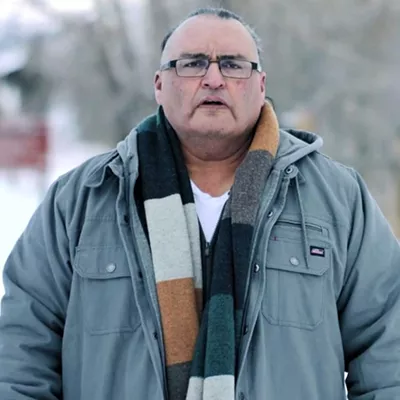Through his work, Castanza illuminates a waning culture of artists who live and work in the historic Warehouse District, threatened by the city's financial and transportation interests.
For this exhibition, New Paintings, Castanza created portraits of these artists in the hopes that the images will form questions in the minds of viewers and catalyze change. His work is on display at Tooley's on Congress, 278 E. Congress St., through Saturday, Aug. 23. Tooley's on Congress is open Monday through Thursday, 7 a.m. to 10 p.m.; Friday and Saturday, 7 a.m. to 11 p.m.; and Sunday, 7 a.m. to 5 p.m. Admission is free. Call 203-8970 for more information.
Each of the portraits is a 12-inch-by-12-inch oil-on-canvas painting of a different artist. Castanza said "the redundancy of the mug shot style makes more of an impact" and shows that the artists are, in a way, "prisoners." Though Castanza has chosen forward-facing poses and plain backgrounds, the overhead lighting and mild expressions in many of the portraits lend a saintly aura to the subjects.
He explained that the artists are being forced out of the Warehouse District, because many of the buildings that house their studios are owned by the city and the Arizona Department of Transportation, which have other plans for the space.
"We're losing it (studio space) for several reasons: We're losing it to developers who are coming in and buying either the building or the land from the city or ADOT, or the city is reclaiming the buildings to make way for the new road they want to build for Barraza-Aviation (Parkway)," said Castanza. (See "A Park's Plight" on Page 15 for more information.)
Many of the studios in the area are rented to artists at low cost by ADOT, and for many, moving to another location just isn't an option. Also, said Castanza, forcing artists out of the Warehouse District will ruin the impact of Tucson's art community on the downtown area.
"If we lose the studios we're in now, we're not going to be able to afford to continue to be in downtown and still have that presence," said Castanza. "I think they (artists) had a large part in creating the atmosphere and culture, the feel that downtown has. They contribute to that greatly. I like the feel and kind of the aroma they created downtown by being there."
He hopes that artists in the community can find a way to continue their contribution to the ambiance of downtown Tucson, while maintaining their livelihoods.
The portraits reflect a variety of artists and craftspeople--from painters and sculptors to writers and welders--who currently work in the area, or have in the past. Castanza said that while there are about 14 paintings in this exhibition, he has made 20 to 30 local artists' portraits and has plans to do more.
In future paintings of downtown artists, Castanza said he will aim for a "less-posed" style, he said. To paint the portraits on display in this show, Castanza worked from photos he took of the artists.
The portrait project not only introduces Tucsonans to the artists operating downtown, but also gave Castanza an opportunity to meet his new neighbors. Castanza grew up in Tucson, but left to attend the Ringling College of Art and Design in Sarasota, Fla., and to work on the East Coast for a while, before returning.
"When I came back here, I wanted to re-introduce myself and meet all of these artists that have been downtown, and I just kind of stumbled upon them, so I just thought that was a good way for me to meet a lot of our--we kind of call them our elders," he said. "They've been here forever, and they've created this whole culture and society of artists down here, just by being here and surviving."
Most of them were excited to contribute their image to the project, said Castanza, who works in a studio at 44 W. Sixth St. He said he and others have also been trying to strengthen the art community by encouraging more professional artists to rent studio space in the area.
"I felt strongly about coming back to Tucson, the place where I grew up, and to contribute to Tucson and have a presence here," he said.







